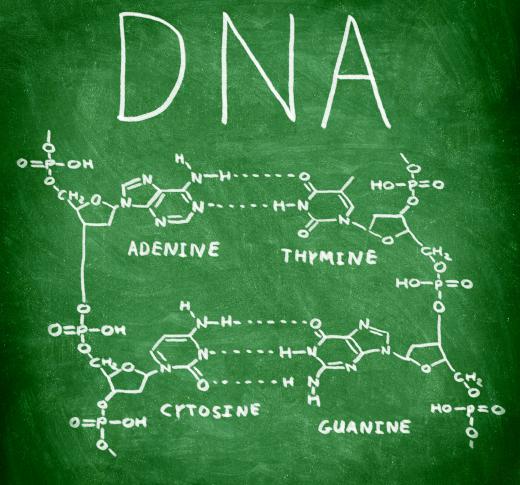What is Adenine?
Adenine is one of the nucleobases present in deoxyribonucleic acid (DNA) and ribonucleic acid (RNA), the genetic information stored within organisms. It is a substance often studied in biochemistry because of its many important roles in the bodies of organisms. It has the chemical formula C5H5N5. It is a purine, meaning that it is a kind of organic compound that is composed of carbon and nitrogen atoms arranged in the form of two rings.
DNA and RNA are extraordinarily important nucleic acids because they contain the genetic information used for the growth, repair, development, and reproduction of all organisms. They are each made up of four nucleobases: DNA is composed of adenine, thymine, guanine, and cytosine; RNA is composed of the same, but with uracil instead of thymine. The arrangements of these nucleobases determine the exact nature of the genetic code contained in the DNA or RNA. Adenine is one of these nucleobases, so it is of the utmost importance to the genetic structure of all living organisms.

In DNA, adenine bonds only to thymine. It does so with two strong hydrogen bonds, so the bond is difficult to break and the code is difficult to damage. In RNA, adenine bonds with uracil; the particular kinds of reactions that RNA is involved in favor uracil to thymine. In both cases, the particular arrangement of nucleobases determines the genetic properties of the nucleic acid.

It was initially thought that Adenine was actually vitamin B4. It is not considered to be a direct part of the B vitamin family anymore, though some B vitamins do bind with it with varying effects. This is most notably true of niacin and riboflavin, which bind with it to form cofactors, which are required for some proteins to function properly.
Adenine is not exclusively found in nucleic acids; many different substances, such as some blends of tea, actually contain the nucleobase. It can also form a variety of compounds that are very common in nature and in some foods and drinks. Cobalamim, more commonly referred to as vitamin B12, is actually a compound of adenine known for its energizing effects and is a natural antidepressant. Adenosine triphosphate (ATP) is another compound that contains adenine; it is known for its role as a major energy source that is derived from cellular respiration. Glucose is broken down into ATP, which is a very significant energy-containing molecule used by a vast variety of organisms.
AS FEATURED ON:
AS FEATURED ON:
















Discussion Comments
@cardsfan27 - Adenine is a purine. The second group you are thinking of is the pyrimidine group. I'm kind of surprised I remember that from so long ago. At this point, though, I couldn't tell you what the differences are. Obviously, it is something with the base structure and how their molecular makeup.
Theoretically, in DNA, adenine always pairs with thymine, but what happens when some of the base groups get mixed up? I remember there are a bunch of different ways the bases can end up in the wrong order.
@TreeMan - Glucose gets transformed into ATP through cellular respiration, which is the process responsible for creating energy. It is what causes us to breathe out carbon dioxide, since that is the main byproduct.
I remember from my biology class that adenine and thymine belong to one group of nucleotides and cytosine and guanine belong to another group. I remember one of the groups was purines. Is adenine a purine or the other one? What is the difference?
When glucose is broken down for energy, it can't be directly converted to ATP, right? Gucose is only made of carbon, hydrogen, and oxygen, but ATP at least has nitrogen from adenine and phosphorous. How does it end up at ATP?
I never knew adenine was involved with any major molecules except for DNA and RNA. I knew what the real name of ATP was, but I guess I never put two and two together.
Adenine is important in creating proteins, but how is adenine created in the first place? Can it be made in body cells, or does it have to be ingested from the ATP in foods?
Does adenine have any other important uses besides DNA and ATP?
Post your comments